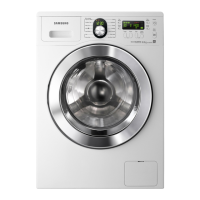Do you have a question about the Samsung WF1704WSV and is the answer not in the manual?
Enhances cleanliness and fabric care with advanced Eco Bubble technology.
Specific wash programs for quick cleaning, outdoor gear, and baby clothes.
Delicate wash cycle using appropriate temperature and gentle action.
Self-cleaning cycle and child lock feature for hygiene and safety.
Delay start function and intuitive digital control panel.
Features for convenience, leak prevention, and energy saving.
Essential guidance for safe and efficient operation of the appliance.
Explanation of warning symbols and precautions for user safety.
Guidelines on preventing child access and proper appliance placement.
Information on the correct disposal of electrical and electronic equipment.
Critical warnings for safe installation, including electrical safety.
Precautions for electrical connections, grounding, and power supply requirements.
Warnings regarding suitable installation locations to prevent hazards.
Critical warnings and precautions for safe operation during use.
Prohibition of washing items contaminated with flammable or explosive materials.
Safety guidelines for operation, unplugging, and self-repair avoidance.
Precautions for cleaning, handling, and potential risks during appliance use.
Measures to prevent risks associated with hydrogen gas and gas leaks.
Warnings against misuse, chemical spraying, and washing specific items.
Safety advice for detergents, oils, and handling special laundry items.
Avoidance of specific soaps and detergents that may damage the washer.
Critical safety warnings related to the cleaning process of the appliance.
Verify all included parts are present after unpacking the washing machine.
Identification of main external components like the work top and power plug.
Guidelines for safe electrical connection, grounding, and power requirements.
Specifications for water pressure and tap accessibility for proper filling.
Requirements for drain hose routing, standpipe height, and floor stability.
Considerations for surrounding temperature, alcove clearances, and ideal installation location.
Instructions on how to remove shipping bolts before installing the washing machine.
Steps to level the washing machine for stability and proper operation.
Detailed instructions for connecting the cold and hot water supply hoses.
Specific steps for connecting water supply hoses using an adaptor for certain models.
Ensuring secure connections and checking for leaks after water supply installation.
Instructions for connecting the Aqua Hose for enhanced leakage protection.
Guidance on positioning the drain hose in three different ways.
Instructions for plugging the washing machine into an approved electrical outlet.
Procedure to run an empty cycle before first use to remove residual water.
Guidelines for loading laundry, adding detergent, and starting a wash cycle.
Overview of the control panel layout, indicators, and functions.
Details on various wash cycles like Cotton, Synthetics, Denim, etc.
Using buttons for prewash, setting delayed end times, and selecting temperatures.
Selecting rinse cycles, spin speeds, and wash options like Soak and Intensive.
How to use the Eco Bubble and Quick Wash functions for efficient washing.
Functions of the Start/Pause and Power buttons for cycle control.
How to activate/deactivate Child Lock and Sound Off features.
Detailed explanation of setting and cancelling a delayed wash cycle.
Explanation of Eco Bubble function availability and operation across different courses.
Step-by-step guide to selecting cycles and options using the control panel.
How to add/remove laundry mid-cycle and what to do after completion.
Instructions for manual washing without using the cycle selector.
Guidelines for sorting laundry, checking labels, and emptying pockets.
Chart to determine load capacity based on fabric type and model.
Guidance on choosing appropriate detergent based on fabric, color, and temperature.
How to use the detergent drawer compartments for detergent and fabric softener.
Specific instructions for using liquid detergent with a special box.
Instructions for using the self-cleaning ECO Drum Clean course.
Procedure for draining water from the machine in an emergency situation.
Steps to clean the detergent drawer and its recess.
Instructions for cleaning the debris filter to ensure proper drainage.
How to clean the external surfaces of the washing machine.
Procedure for cleaning the water hose mesh filter annually.
Steps for repairing a frozen machine and guidance on storage.
Solutions for when the washing machine does not start.
Troubleshooting issues related to water supply and pressure.
Resolving issues with detergent in the drawer and unusual noises.
Troubleshooting problems with draining, spinning, or the door lock.
Solutions for dE, 4E, and 5E error codes related to door, water, and drainage.
Troubleshooting UE, CE/3E, and Sud errors for load balance and foaming.
Understanding and resolving issues related to voltage instability (Uc).
Detailed chart of wash programs, load capacities, and settings for user selection.
Explanation of symbols and guidelines for garment care directions.
Information on responsible disposal and eco-friendly usage.
Statement of compliance with European safety standards.
Technical details for WF1804/WF1802/WF1800 models.
Technical details for WF1704/WF1702/WF1700 models.
| Water consumption per cycle | 56 L |
|---|---|
| Energy consumption washing per cycle | - kWh |
| Annual water consumption washing | 9400 L |
| Annual energy consumption washing | 173 kWh |
| Door color | Silver |
| Control type | Buttons, Rotary |
| Loading type | Front-load |
| Product color | - |
| Built-in display | Yes |
| Appliance placement | Freestanding |
| Drum capacity | 7 kg |
| Spin-drying class | B |
| Maximum spin speed | 1400 RPM |
| Noise level (spin) | 78 dB |
| Noise level (wash) | 62 dB |
| Package weight | 70000 g |
| Width | 600 mm |
|---|---|
| Height | 850 mm |
| Weight | 66000 g |












